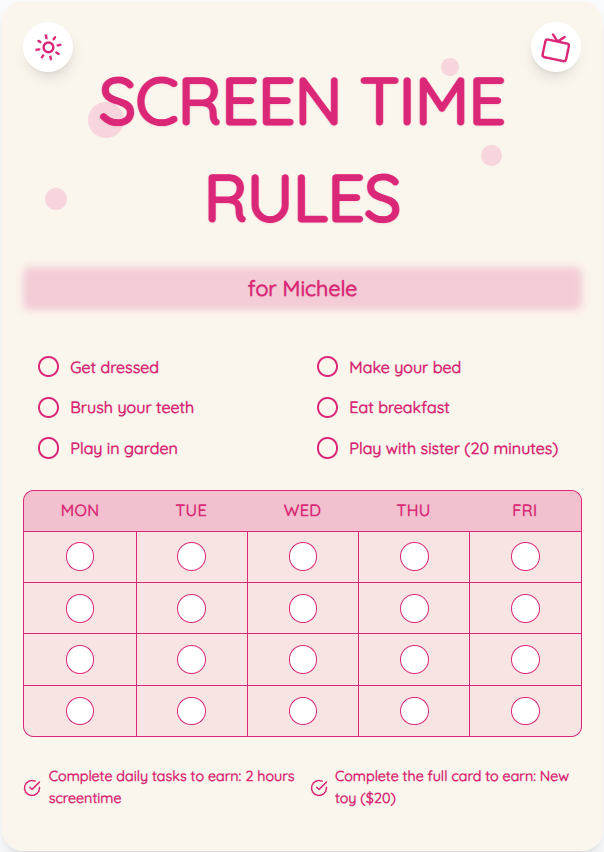The Truth About Screen Time and Myopia in Adults
As a parent, you may wonder whether excessive screen time can lead to myopia in adults. This comprehensive guide delves into the relationship between screen use and vision health, providing actionable advice for managing screen time effectively.
See What Your Screen Time Chart Will Look Like
Here's an example of a beautiful, customizable screen time rules chart you can create for your family

Understanding Myopia and Screen Time
Myopia, or nearsightedness, is a common vision problem where distant objects appear blurry. Research suggests a potential association between increased screen time and the development or progression of myopia in adults. Prolonged screen use can lead to eye strain, fatigue, and focusing difficulties, which may contribute to vision issues.
Practical Tips for Managing Screen Time
1. Set screen time limits for both children and adults to reduce overall exposure. 2. Encourage regular breaks to rest eyes and prevent eye strain. 3. Use the 20-20-20 rule: every 20 minutes, look at something 20 feet away for 20 seconds. 4. Ensure proper lighting and ergonomics when using screens to minimize eye discomfort.
Put These Tips Into Action
Create a custom chart to implement these strategies with your child
Balancing Screen Time with Outdoor Activities
Promote outdoor play and activities that involve looking into the distance, which can help reduce the risk of myopia. Encourage children and adults to engage in hobbies that don't involve screens, such as sports, reading physical books, or arts and crafts.
Creating Healthy Screen Time Habits
Establish screen-free zones in your home, such as the dining area or bedrooms, to promote healthy boundaries. Use screen time charts from ScreenTimeRules.com to set clear guidelines and track usage for the whole family. Model good screen habits for your children by limiting your own screen time.
Practical Tips for Success
- Set screen time limits for all family members
- Encourage outdoor activities to reduce screen exposure
- Use the 20-20-20 rule to prevent eye strain
- Establish screen-free zones in your home
Frequently Asked Questions
Can adults develop myopia from excessive screen time?
While myopia is more commonly associated with childhood, adults can also experience vision changes due to prolonged screen use. Managing screen time and practicing good eye care habits can help mitigate these effects.
How can I protect my vision health while using screens?
To protect your vision health, follow the 20-20-20 rule, maintain proper posture and lighting, take regular breaks, and ensure your screens are positioned at an appropriate distance to reduce eye strain.
Are there specific activities that can help prevent myopia?
Engaging in outdoor activities that require looking into the distance, such as sports or nature walks, can help prevent or slow the progression of myopia. Limiting screen time and incorporating varied visual tasks are also beneficial.
By understanding the impact of screen time on vision health and implementing practical tips to manage usage, you can promote healthy habits for your family. Visit ScreenTimeRules.com to access customizable screen time charts that simplify setting limits and fostering a balanced approach to technology use.
Ready to Transform Your Family's Screen Time?
Join thousands of parents who have successfully managed screen time with our customizable charts.
